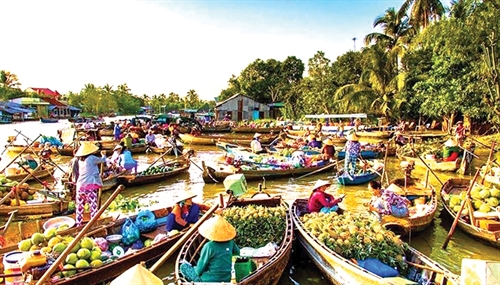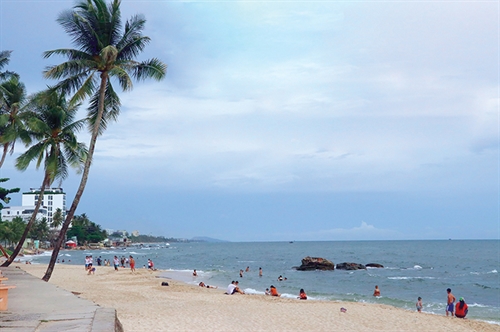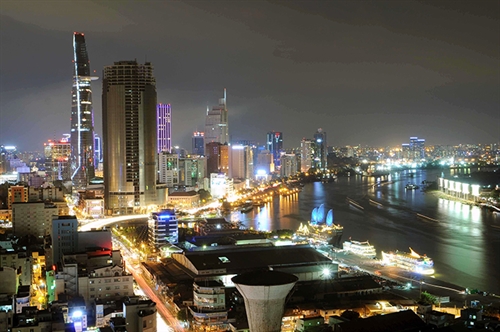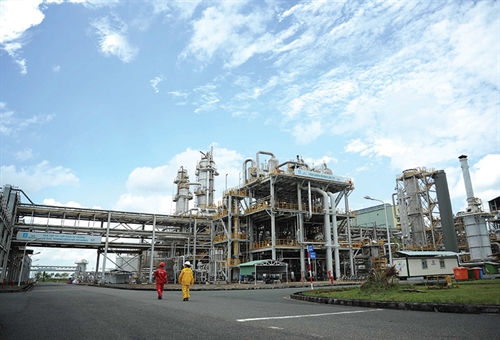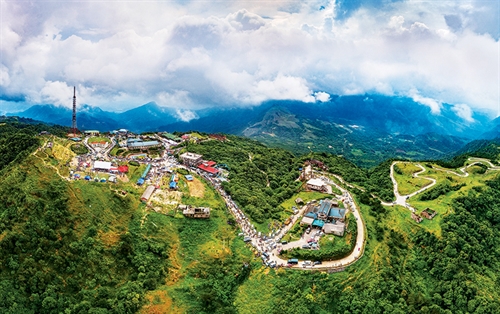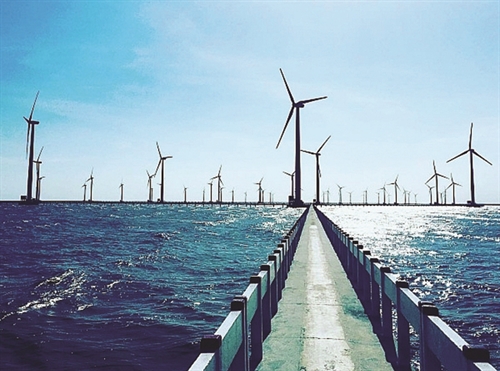Located in the central coastal region of Vietnam and leaning against the Truong Son mountain range, Quang Binh province borders Ha Tinh province to the north, Quang Tri province to the south and Khammouane and Savannakhet provinces of Laos to the west with a borderline of 201.87 kilometers and the East Sea to the east. Covering some 8,000 square kilometers, Quang Binh has a population of 896,600 (according to 2019 statistics) and is home to many indigenous ethnic groups such as the Bru-Van Kieu, Chut, Tho, Muong, Tay, Thai and Paco. Apart from Dong Hoi provincial city and Ba Don town, the province has six districts of Tuyen Hoa, Minh Hoa, Quang Trach, Bo Trach, Quang Ninh and Le Thuy.
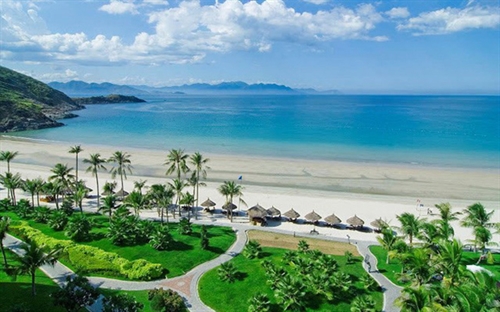 |
| A beach in Quang Binh province__Photo: Internet |
Quang Binh has a pretty narrow and steep topography. Eighty-five percent of the province’s total area is mountains while the rest is hills, forests, plains and beaches. The province is the locality with the minimum breadth of only 40.3 kilometers from its border with Laos to the seashore in the S-shaped country. It has a geostrategic location in both national and international aspects with all national highways, including national expressways 1A and 12, and the Ho Chi Minh trail, and railways, crossing it. In addition, with the Hon La deep-water seaport, Dong Hoi airport and Cha Lo international border gate, Quang Binh is an ideal transshipment point in the East-West economic corridor and eastern gateway to the sea of central Laos and northeastern Thailand and Myanmar.
Renewable energy - new opportunities for FDI attraction
Quang Binh used to be known only for sunshine, wind and sand but now its people are determined to turn these challenges into advantages and strengths. With an average of 1,800 hours of sunshine a year and radiation intensity of between 4 and 4.5 kilowatt-hours per square meter per day and an average wind speed of between 5.5 and 6 meters per second in coastal areas and between 6.2 to 7 meters per second in mountainous areas, the province is calling for investment in solar power plants and wind farms. Among those projects in the fields are the USD 55.6 million 49.5 MWP solar power plant in Le Thuy district invested by the Dohwa Engineering Co. of the Republic of Korea, and the USD 387 million B&T wind farm complex in Quang Ninh and Le Thuy districts invested by the Philippines-based Ayala Corporation. The 210 MW B&T wind farm complex is the biggest inland foreign-invested renewable energy project in the country. Thanks to this project, 45 kilometers of roads leading to 50 windmills along the coast will be upgraded.
The province is to date home to eight industrial parks covering a total area of some 2,000 hectares, the Hon La economic zone and Cha Lo border gate economic zone.
This year, Quang Binh continues calling for investment in tourism, services, real estate; renewable energy and processing industry; supporting industries; clean agriculture and agro-forestry-fishery product processing. In addition, the province is seeking financially capable and experienced partners and investors from the US, the EU, Japan, the RoK, Singapore and Thailand. In the meantime, local authorities and people are creating the most favorable conditions for the Philippines-based Ayala Corporation and the B&T Wind Farm Joint Stock Company to implement the 210 MW wind farm complex, the Solar Philippines Company to conduct survey for a solar power project and the Southeast Asia Capital Group of the US to survey the Hon La general port complex project.
They also provide support to German companies Sowitec and Fortis Home that are studying investment in the Quang Binh 1 wind power plant in Minh Hoa and Tuyen Hoa districts and the STC smart trade center project in Dong Hoi city, respectively.
The Foreign Investment Agency of the Planning and Investment Ministry reported that in the first nine months of 2020, Quang Binh province granted investment licenses to two FDI projects totaling USD 295 million.
The province has so far hosted 23 FDI projects with a total capital of USD 783.5 million.
With both local authorities and people’s determination to attract FDI for provincial socio-economic development and commitment to simplifying investment formalities, Quang Binh has set forth the target of attracting USD 0.6-0.8 billion in the 2021-25 period and USD 1-1.2 billion in the 2026-30 period in FDI.
In the next decade, the province will focus on attracting FDI in sectors of the province’s potentials and strengths, including renewable energy, tourism, services, processing and manufacturing industry and hi-tech agriculture.
Deputy Chairman of the Quang Binh People’s Committee Nguyen Xuan Quang told the Industry and Trade newswire that Quang Binh province would increase and renovate methods of dialogues with investors in order to tackle problems they were facing. In addition, management would also be enhanced to ensure FDI projects are in line with the provincial planning and bring socio-economic efficiency and protect the environment.
Projects that caused environmental pollution, used land inefficiently or have made losses for years or failed to fulfill their commitments would be dealt with, he added.
Tourism - Discovery of mysteries of caves
Quang Binh has a diverse terrain with mountains, lowlands and forests as well as coastal areas and rivers, making it a great place to visit. Quang Binh is dubbed the kingdom of caves as it is home to the Phong Nha-Ke Bang National Park, which was named a UNESCO world heritage site, with plenty of beautiful and spectacular caves. They include Son Doong - the world’s largest cave, which has been listed among “twenty record-breaking natural wonders” by the US news site Insider, with two primeval forests and one underground river; Thien Duong (Paradise) cave - the Asia’s most magnificent system of stalactites and stalagmites and Phong Nha cave with breathtaking underground lakes and rivers and spectacular stalactites. In particular, En (Swallow) cave, the world’s third largest cave, was shot in some scenes of Peter Pan movie by the US-based Warner Bros Entertainment Inc. in 2014 and Son Doong cave was broadcast on Good Morning America - a program of ABC Television of the US in 2015. In addition, the province’s images were also introduced in some scenes of the 2017 Hollywood blockbuster “Kong: Skull Island”.
With a coastline of 116 kilometers, the province is home to the Bang mineral hot spring in Kim Thuy commune, Le Thuy district with an on-spot temperature of 105 degrees Celsius and 29 traditional craft villages such as the Mai Hong forging village in Dong Trach commune, Bo Trach district; Tho Ngoa conical hat making village in Ba Don town and Tho Don rattan and bamboo weaving village in Quang Tho commune, Quang Trach district.
With such assets, the province is an ideal destination for jungle trekking, cave, river, village and farm tours apart from cultural and spiritual tours. However, ideal months for exploring caves are from April through August as there can be flooding during the September to March rainy season.
According to Director Ho An Phong of the Quang Binh Tourism Department, the province has a total of 370 accommodation establishments, including three five-star and five four-star hotels, together with abundant homestays, farm stays and guesthouses. In addition to two existing 18-hole golf courses, the province has just completed the Bao Ninh Truong Thinh golf course project.
The hospitality sector is expected to welcome 5.5 million tourists, including more than 350,000 foreigners, and rake in a turnover of around VND 6,380 billion (USD 265 million) this year.
However, due to impacts of the COVID-19 pandemic, the number of tourists to the locality dropped sharply but the hospitality sector is expected to recover since the ease of social distancing.
To stir the tourism market in the post-pandemic period, the Quang Binh People’s Committee on May 6 issued an official letter on the price reduction of tourism products and services. In response to the act, a new tourism promotion program, called “Quang Binh - a safe and different destination” has been launched. The program’s promotion package, lasting from mid-May until the end of this year, offers attractive price discounts for excursions, accommodation, food and beverages, and transportation while ensuring the highest quality standards.
Accordingly, entrance and transportation fees are slashed by half, reducing the entrance fee for the world’s largest cave system to VND 4.4 million (approximately USD 180).
Oxalis Adventure, the leading adventure tour operator in Vietnam, also lowers the price of the tour “Conquering Son Doong - the world’s largest cave” to USD 2,500 per tourist.
In addition, many hotels offer irresistible discounts of up to 30 percent for rooms and other services.
The Quang Binh People’s Committee reports that the province welcomed 2,600 foreign holiday makers and earned a turnover of VND 825 billion in the third quarter of this year, bringing the total number of nine-month foreign holiday makers and turnover to 54,430 and VND 2,037 billion, respectively.- (VLLF)
